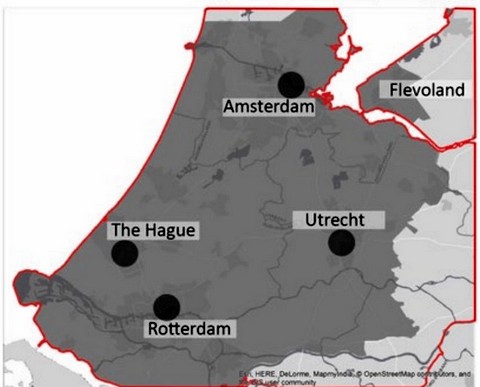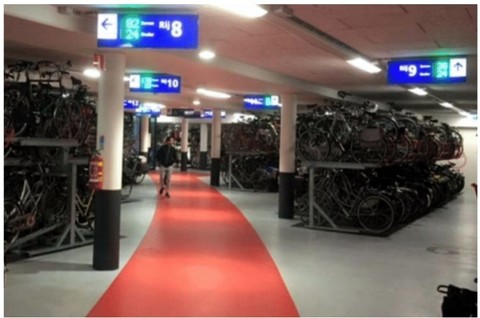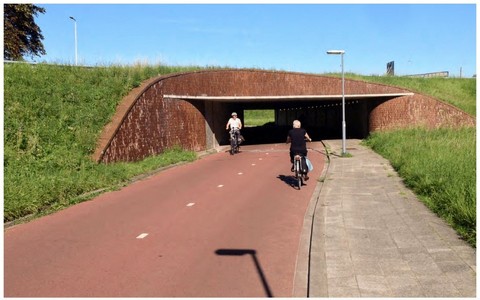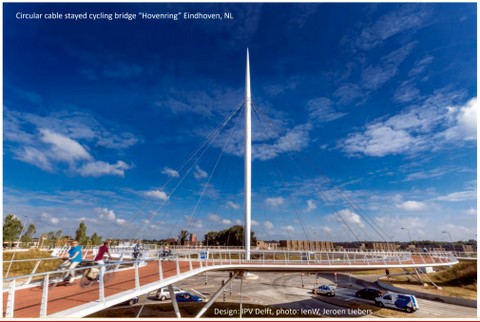Netherlands Spreads the Word on Getting Around on Two Wheels
Cycling is a great way to reduce automotive traffic, especially in crowded urban settings. The residents of the Netherlands are experts and want to help other nations understand the benefits of cycling, build out cycling infrastructure and ride safely. To do this, they have established the Dutch Cycling Embassy.
“The Dutch Cycling Embassy is a vast network of public and private organizations from the Netherlands who wish to share their expertise on building what supports the Dutch cycling culture to those interested.”
I recently attended an interesting online presentation by the Embassy. The initial portion included an introduction by Chris Bruntlett, the Embassy’s marketing and communications manager. Derek Taylor of Goudappel also spoke. This was followed by a choice of three simultaneous breakout sessions; I attended one on the design and building of cycling infrastructure.
Some Impressive Dutch Two-wheel Stats

The Netherlands is the number one country in the world in bike ridership. This nation of 17 million residents owns 23 million bikes—more than one per person! They take five million bike trips each year, averaging about 621 miles per person. There are 202 cities and towns where bike share actually exceeds car share (for trips shorter than 4.7 miles). And today, 18 percent of bike trips are by electrical assist, and 26 percent of all miles ridden are by e-bikes.
What helps it run so well is that cycling is incorporated into the public transit system. Half of all train trips begin with a bicycle ride to the station. The Embassy’s slides showed vast bike parking facilities there.
Goudappel Coffeng
Derek Taylor, the mobility analyst and business developer from Goudappel Coffeng spoke.
Goudappel Coffeng is a Netherlands-based company with 60 years of mobility planning experience and currently has 250 experts on staff. Its slogan is “Mobility Moves Us” (Mobiliteit beweegt ons). Derek lives in the San Francisco Bay Area and understands what’s relevant to the local community.
The Netherlands, the world’s transport-safest country, has a balanced modal share—30 percent car, 30 percent public transit, 30 percent bikes and 10 percent pedestrian (or other). And it’s fully integrated, too, with residents using a single card for local, regional and international travel.

Derek described the similarities between the Dutch Randstad Economic Region and the Bay Area. The Randstad encompasses the four largest cities in the Netherlands, which are located in the western part of the country. The four cities are Amsterdam, Utrecht, Rotterdam and The Hague. This maps fairly closely to the Bay Area, which includes the cities of San Francisco, San Jose and Oakland, and all the smaller cities in between.
A huge difference, though, is that the Bay Area uses a lot more cars! For comparison, the car to non-car ratio in Amsterdam is 30/70 percent while it’s 88/12 percent in San Jose—utterly the opposite. How do they do that in the Randstad?
The answer is, they take an integrated approach to mobility planning and land use planning, considering the urban form, buildings and special design. Dutch cities have even created some car-free zones.
A good way to remove cars is to make it easy to live without them, so there is a hierarchy of travel modes, all integrated:
- International–high speed trains
- Interregional–Intercity trains
- metropolitan–metro, light rail, commuter rail
- local–trams, buses, cycling
The Bay Area doesn’t have this kind of integration, and there’s really no land-based international travel. As it is, about 7.7 million people live in the Bay Area, and the area has the fifth largest GDP in the U.S. In a challenge for cycling, 33 percent of Bay Area residents work in a different county from where they live, and 75 percent drive to work. According to Derek, traffic congestion has increased 80 percent since 2010, especially at high travel times, and it was growing rapidly (in pre-pandemic times).
Many people live within 1.25 miles of an existing rail station (BART and CalTrain) and could possibly cycle to the station and take transit if the transit system was set up for it. Derek talked about catchment zones, which have five percent of the land but 51 percent of the jobs and are good transit hubs. So, for example, the Salesforce Transit Center in downtown San Francisco is ideal, and commuters could bike to the train stations and go to work from Salesforce (or even in it—it’s the tallest building in San Francisco). This of course is in the world after COVID-19 is under control.
The E-Bike Design and Planning Breakout Session
The three speakers in this session taught me a lot about how cycling infrastructure decisions are made and how those beautiful Dutch bike paths and structures get designed and built.
Kennisplatform Crow

Kennisplatform Crow is an e-bike design and planning company in the Netherlands. Project manager Hillie Talens talked about how Crow considers the user’s perspective in design decisions. The Netherlands has a road classification system that helps develop guidelines for safety.
- Motorways (no bicycles)
- Access roads
- Distributor roads (to connect them)
Hillie discussed five safety principles that Crow considers when designing cycling paths and structures:
Functionality–It does the job as well as possible.
Homogeneity of mass, speed, and direction–moving at the same speed helps avoid accidents.
Recognizability of road design and predictability of the road course and road user behavior–signage is consistent and placed consistently.
Forgivingness of the environment (physical and social)–help eliminate problems by allowing room for errors and enough space for safe passage.
State awareness by the road user.

Crow considers five main bicycle infrastructure requirements:
Coherence–The system is complete, connected and consistent, and cyclists have no trouble finding their way. Bicycles combine well with cars and public transit and offer route choices.
Directness–Eliminate unnecessary detours and allow for a constant speed with a minimum of delays.
Attractiveness–Include variety and surprise, activities along the route, positive stimuli for all of the senses, and keep bikeways clean, whole, well-tended.
Safety & Health–Mix bikes with cars when possible and separate them when necessary for low-speed and volume and provide alternative parallel pathways for high volume. Consider infrastructure and land use, such as location of schools.
Comfort–Provide a smooth surface (concrete/asphalt), minimal stops, protection against the weather, avoid steep slopes, make sure there’s enough space (abreast), avoid sharp curves and design for a speed of 20 mph.
Other factors include positioning bollards marked with reflective material, streetlighting, keeping vehicles out of bike paths, and providing enough bike parking spaces.
Mobycon
Mobycon is an independent consultancy firm based in the Netherlands. Its interdisciplinary team includes urban designers, planners, economists and social scientists who are well-versed in applying Dutch transport expertise around the world. Lennart Nout, manager of international strategy, guided us through his presentation.
Mobycon wants to make the world less dependent on the car. In the Netherlands, people cycle not only on short city trips but do some long-distance commuting, too. That means investing in bicycle highways, not just bike paths along existing roads. Research has found that providing designated bike lanes helps get more riders to take short trips. Mobycon is working on a fully segregated bicycle highway in Los Angeles.
Like Hillie, Lennart mentioned three different types of roads, which he labels flow, distribution and access. Mobycon has found that creating low-traffic residential neighborhoods unlocks high bike use. Motorists are willing to drive shorter distances at slower speeds within them, which is safer for cyclists. You can plan out a neighborhood where you can get where you need to go in six minutes. Lennart showed an example of how, in Barcelona, they put the cars on the outside of “superblocks” and the cyclists inside.
Bike Minded
Bike Minded is located in Rotterdam, the Netherlands (NL);. its goal is co-designing a bicycle friendly world by creating e-bike infrastructure. The company is concerned with signage and technical elements such as bridges. Company founder Maurits Lopes Cardozo was our guide.

E-bikes are growing steadily in the Netherlands. From two percent in 2004 to 42 percent of bicycle purchases today. With reduced effort, more people can use them, and it enables higher travel speeds, which makes longer trips possible—and has an effect on urban planning. It could have a large impact in the Bay Area, too.
Pedal-assist bikes used to be for seniors and people who had difficulty riding a bike, but now they are used by many other people, including for delivery and even schoolkids.
Maurits described two types of cyclists—practical and recreational—and says that both types would be willing to switch to e-bikes. Practical cyclists are everyday cyclists: commuters, people carrying cargo, or students going to school. Recreational cyclists are of all ages, are often e-bike users, and enjoy riding for sports and fun.
The two cycling types have different needs, but it all requires good infrastructure. While the main cycling network in town can be on asphalt streets, there are some fast-cycling regional routes for longer distance commutes. Maurits talked about three hierarchies of cycling: basic, main and fast.
- Basic can share streets at slow speeds
- Main needs a separated path—red-painted asphalt in the Netherlands
- Fast-cycling routes do not mix with cars, and are for longer commutes and recreational rides
For those longer trips, there are often barriers, such as highways, rail and utility corridors, rivers and canals, which divide neighborhoods. Car-dominant intersections are a problem, too. So, Bike Minded plans and designs ways to surmount these barriers. For example, the amazing Hovenring in Eindhoven, NL, is a circular cable-stayed cycling bridge that floats over the highway. Maurits showed us the Los Angeles River Bike Path and the City of Davis’ bike infrastructure projects.
The ideal situation is to integrate cycling seamlessly with other transport networks, and that sometimes is not parallel to the car network. Minimal contact with other modes is much safer. That’s why Bike Minded likes roundabouts in place of intersections, such as in Beukelsdijk in Rotterdam. They are much safer and keep all traffic, cars and cycles, flowing smoothly.
The Last Word from Chris Bruntlett
Chris Bruntlett, based in Delft, the Netherlands, uses his knowledge and passion for cycling to share what the Netherlands has to offer with other locations around the world.
Per Chris, regular unassisted bikes can be part of the picture, but e-bikes are transformational.

“Switching just a fraction of automobile trips to the electric bicycle could save societies billions, addressing myriad problems such as obesity, congestion, air quality, noise pollution and road safety,” he said.
However, there are three major barriers to realizing these benefits: lack of infrastructure, lack of storage and the up-front expense. That means e-bikes won’t be used in large numbers without creating safe places to ride and park them and providing incentives to make it easier to buy one.
“This seemingly limitless potential to transform our cities and towns won’t be fully realized without additional support from both the public and private sectors,” Chris said.
So, the best things you can do now are to join like-minded people and organizations to push for change, lobby your elected officials, and if all else fails, run for elected office yourself. And, of course, go get your own e-bike.
Story by Steve Schaefer. Photos from the Dutch Cycling Embassy.
More of our Biking Coverage
Micromobility: Test Ride: VanMoof S3 E-bike
Micromobility: Behold—A Revolutionary Bike Helmet
Micromobility: An Electric Mercedes-Benz for One
Riding the Specialized Turbo Electric-Assist Bicycle
